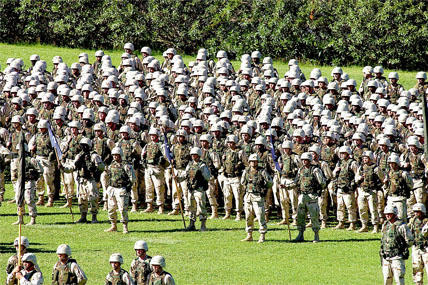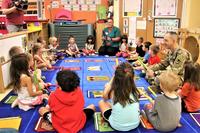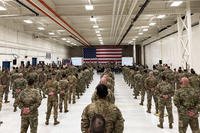Strictly speaking, "deployment" refers to activities required to move military personnel and materials from a home installation to a specified destination. For servicemembers and families, it has come to mean much more: the preparations and personal needs that need to be taken care of at home before, during and after deployment.
Deployment for active servicemembers and National Guard and Reserve members, as well as Individual Augmentee (IA) deployment, follows these cycles:
1. The Active Duty Deployment Cycle
Pre-deployment phase
When not deployed, servicemembers and their units undergo traditional training to prepare for the conduct of military duties. During this phase, servicemembers go through normal training and medical evaluations that maintain their personal and unit readiness level. From the family point of view, this phase is "normal life," as the servicemember is at home and going to work on a regular basis. Near the end of this phase, the unit will be alerted for possible deployment and will receive orders to mobilize. Upon receiving a mobilization alert, preparation for deployment begins, including required briefings, additional training, medical and dental evaluations, and possibly counseling to ensure that service members are ready and able to be deployed. The pre-deployment phase ends when service members or their units physically leave the home installation for the theater of operations.
Deployment phase
The deployment phase of the cycle begins with the physical movement of individuals and units from their home installation to the designated theater of operations. This phase of the deployment cycle can be a stressful time for servicemembers and their families as they face the realities of a deployment and what that means for them. The remainder of the deployment phase primarily involves the performance of military duties in support of the mission either in the theater of operations (overseas) or within the United States. Near the end of the deployment phase, the unit will begin preparations for its return to the home installation, culminating with the unit’s redeployment home.
Post-deployment phase
Servicemembers return to their home installation, and prepare to "reintegrate" into normal life, with individual branches of service offering additional briefings, training, medical evaluations, and counseling to assist. In the post-deployment phase, active duty service members will be ready to return to their normal jobs on the installation.
Reintegration phase
This phase includes reintegration into family life and the community, as well as reintegration into regular military duties. Units may require servicemembers to complete follow-on briefings, training, counseling, and medical evaluations during this phase. Servicemembers and their families may experience some stress during this phase, as everyone readjusts to life together. Many support services are available for service members and their families to make this readjustment easier, either through the branches of Service or through the community.
2. The Reserve / Guard Deployment Cycle
Pre-deployment
This phase is similar to the active duty pre-deployment phase in that the servicemember is living a "normal life," and undergoing regularly scheduled training and medical evaluations that maintain their personal and unit readiness level. When servicemembers receive a mobilization alert they will be given briefings, additional training and medical evaluations in preparation; the pre-deployment phase ends when servicemembers or their units physically leave the home installation for the theater of operations.
Deployment, Post-deployment and Reintegration Phases
Same as active duty deployment phases (see above).
3. Individual Augmentee Deployment
Individual augmentee (IA) deployment occurs when a servicemember receives orders to deploy individually or with a small group to augment a different unit. This type of deployment is different from deployments that occur when an entire unit, squadron, or ship is ordered to deploy. An IA can be an active duty, a National Guard, or a Reserve service member, and can either volunteer for IA service or be selected for it. usually IAs are Navy and Air Force service members that augment an Army or Marine Corps unit. Deploying IA Sailors and Airmen usually require additional training and can be ordered to tours longer in length than a traditional deployment.
When called for an IA deployment, service members usually have shorter notification times, lack specific information concerning their deployment, and are often deployed to areas that present communication challenges. More information on the IA program can be found on these websites:
• Individual Mobilization Augmentee (IMA) Program, Army Human Resources Command (HRC) (requires Common Access Card (CAC) login)
• Army Reserve Individual Ready Reserve (IRR), IMA, United States Army Reserve Command (USARC) Augmentation Unit (UAU), and IA
• IMA Program, Marine Corps Mobilization Command (MobCom)
• United States Navy IA Sailor, Family, Command, and Employer, United States Fleet Forces Command
• Expeditionary Combat Readiness Center (ECRC), Navy Expeditionary Combat Command
• Air Force Reserve Command (AFRC)
4. Deployment Assistance
Once a servicemember is mobilized, family members may find they need assistance with a particular problem or be in need of general support. Regardless of which military branch the Reserve is serving in, family members can receive services from any military installation. What is available will vary according to installation staffing, active duty population, and geographical isolation. If you do not live near an installation, many of the services can be provided via the telephone and e-mail.
Family Assistance Center:
The State Area Command (STARC) within the State National Guard Military Headquarters will usually activate a Family Assistance Center (FAC) when a reserve unit is mobilized. The FAC will provide current information concerning family support available within the state to include military, federal, state, and local civilian support to military family members. It will also provide government forms and assistance in filling them out. Check with your STARC to locate the FAC nearest you.
Fleet and Family Support Center:
Active military bases have a Navy Fleet and Family Support Center, Marine Corps Community Service Center, Air Force Family Service Center or Army Community Service Center. Although names vary, most of the services are the same. Centers are staffed by highly trained human services professionals and volunteers. All programs are free of charge.
For more on the Navy Fleet and Family Support Center, click here.
Services offered by these service centers include:
Financial Management Assistance: Professional counseling available regarding financial management including budget preparation, understanding the LES, investing, debt management, and credit management.
Relocation Services: This program offers assistance to military members and their families in relocating from one installation to another. Provides useful and interesting information regarding local community and travel. Operates loan locker for basic necessities and SITES program (web-based information on world-wide military installations).
Exceptional Family Member Program: Maintain and provide up-to-date information for families who have a special need family member. Information includes local special education programs and medically-related services available aboard base and in the community.
Information and Referral: This is the place to start if you are not sure of what you need. Will provide general assessment of situation or problem and make appropriate referrals to needed resources.
Career Resource Center: Seminars, classes, testing, and individual counseling available for vocational and career development. Provides information on local employment opportunities and educational programs. Service members and spouses are eligible for services.
Individual and Family Counseling: Professional counselors will provide confidential short-term counseling services, information, and referrals. Life skills classes and groups are generally offered.
Family Advocacy Program: Assistance is provided for situations involving child abuse, child neglect, or spouse abuse. Classes and groups geared toward preventing family problems are generally offered. Confidential victim advocacy is generally offered.
Retired Affairs: Provides benefits information for veterans.
Air Force Aid Society (AFAS):
AFAS is a private non-profit organization whose mission is to help relieve financial distress of Air Force members and their families and assist them in financing their higher education goals. Active duty and retired Air Force members and their dependents are eligible for AFAS assistance, as are the dependents of deceased Air Force personnel who died on active duty or in retired status. Reservists and National Guard members serving on extended active duty over 30 days are eligible as well, but assistance is limited to emergencies incident to or resulting from the applicant's active duty tour.
Spiritual Help:
Often in times of stress, it is best to get spiritual support. Take advantage of military chaplains and enlisted religious support personnel, who are there to help and serve military members and other authorized personnel.
Unit, Personal, Family Readiness Program (USMC):
The Unit, Personal, Family Readiness Porgram (UPFRP) is an official Marine Corps program. It is a unit centric program, guided by a Command Team that reinforces the relationship between the unit and the services relevant to the unit, the unit members, and their families. The primary goal of UPFRP is to empower Marines and family members, providing them the opportunities to not just survive but to thrive while taking on the challenges of the military lifestyle. The Family Readiness Officer (FRO) is responsible for implementing the Commander’s family readiness vision, managing the UPFRP, and providing the necessary support to the unit Marines, Sailors and families to maintain a constant state of family readiness.
Navy-Marine Corps Relief Society:
The Navy-Marine Corps Relief Society is a private, nonprofit organization that helps the Navy and Marine Corps take care of their own. It may provide financial assistance for a variety of valid needs, ranging from the costs of setting up a household to disaster relief. However, the Relief Society does not assist with the purchase of nonessentials, nor does it supplement the income of persons who habitually live beyond their means. Interest-free loans, grants, or combinations of loans and grants may also be approved.
Emergency transportation: Food, rent, and utilities. Help when disaster strikes Personal needs when pay is delayed Essential vehicle repairs.
Education loans for family members: Visiting nurse for mothers of newborns, and housebound retirees. Layettes for qualified families and "Budget for Baby" classes. Budget counseling. Thrift shop.
Legal Assistance:
Active duty members, activated Reserve and Guard members, and their family members are eligible to seek legal aid and assistance from any military installation where there is a legal assistance office. A Legal Assistance Officer provides counseling and assistance with personal legal problems, claims services, and trial defense services. Legal advice and assistance available.
Wills, powers of attorney, and bills of sale. Domestic relations (adoption, separation, nonsupport) Change of name, notarizations, civil rights, depositions. Citizenship, immigration, and passports. Damage to personal property. Referral to civilian lawyers when appropriate. For more on legal assistance, see Military Law.
Civilian and Community Resources:
American Red Cross: The American Red Cross aids sick and injured service personnel and their families in times of peace and conflict. It also provides social welfare services to needy military personnel and their families. The American Red Cross works closely with all services in providing and assisting in programs relating to the health, welfare, recreation, and morale of military personnel and their families.
American Red Cross services are provided by paid and volunteer staff at offices on military bases and in civilian communities through local American Red Cross chapters. Look in your local phone book to find the chapter nearest you. Some of the services provided by the American Red Cross are:
- Emergency communications
- Health and welfare inquiries
- Information, Referral, and advocacy
- Humanitarian reassignment and hardship
- Discharge review and correction of military records for veterans
- Emergency financial assistance
- Health and Safety Courses Volunteer opportunities
United Service Organization (USO): USO, a private civilian organization, offers centers away from military installations for the relaxation and recreating of service members and their families. Many of the USO centers have snack bars, game rooms, reading rooms, travel and tour centers and other recreational facilities. Some USO centers are located in major airports and provide sleeping berths for adults and children who are awaiting flights.
The USO also works with the Armed Forces to provide live entertainment shows for installation and hospitals in the United States and overseas. Many USO's also offer discount tickets for plays and movies, and can recommend places to stay overnight. The USO now includes help for military personnel and family members with various social problems such as drug abuse, family troubles, and financial stress.
Women, Infants & Children (WIC): WIC is a food and nutrition program funded by the United States Department of Agriculture. Local agencies deliver WIC benefits to participants. WIC helps prevent malnutrition in low-income pregnant females, breastfeeding mothers, new mothers, infants, and children up to the age of 5 years old who are at risk due to inadequate nutrition. WIC provides nutritious foods such as dairy products, beans, and peanut butter. Infants may receive iron-fortified formula, cereal, and juice. Participants receive coupons that they may redeem for food at retail stores which are authorized to accept WIC coupons. Nutritional education and referrals are provided.
WIC is free of cost for eligible participants. To determine eligibility and locate the nearest WIC clinic, call 1(800)345-1942.
State and Local Human Service Agencies:
There are many federal, state, county, and local human service agencies that can provide assistance and information to help solve problems or provide information. Look for "Guide to Human Services" in your local phone book or ask the telephone operator for assistance. Examples of community resources include:
- Department of Social Services
- Public Health Department
- United Way agencies
- Salvation Army/Goodwill
- Parents Anonymous
- Alcoholics Anonymous
- Local churches
- YMCA/YWCA
- Eldercare


















